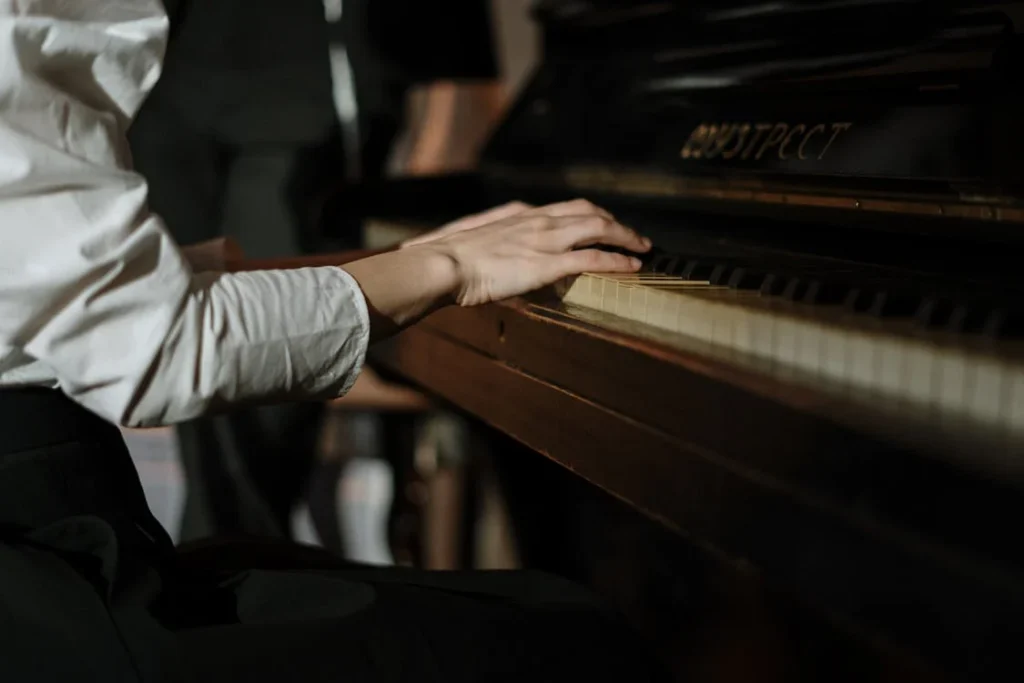Microtones are a unique and intriguing aspect of music that many musicians may not be aware of. Unlike traditional Western music, which typically divides the octave into twelve equal parts (semitones), microtones involve intervals smaller than a semitone. This allows for a richer and more nuanced exploration of pitch, creating unique textures and emotional expressions that are not possible within the standard twelve-tone system.
Learning about microtones can offer new dimensions to musical compositions, allowing for subtle variations in pitch that can evoke different emotions and atmospheres. Microtones have been used in various musical traditions around the world, each with its distinct approach to pitch and harmony.
In this article, we will explore the basics of microtones and check out some composers using microtones in classical music.
- Fall in love with the music - Learn your favorite songs, at a level suitable for you.
- Enjoy interactive piano lessons - Explore courses covering music theory, technique chords & more.
- Get real-time feedback - Skoove's feedback tells you what went well and what needs practice.

What are microtones?
The concept of microtones is not new; they have been used in various musical traditions for centuries. Microtones are musical intervals smaller than the traditional semitone, the smallest interval used in Western music.
While the twelve-tone equal temperament (12-TET) system is the most widely used tuning system in Western music, it divides the octave into twelve equal parts, each representing a semitone. In contrast, microtonal music employs intervals smaller than a semitone, allowing for a more intricate division of the octave.
For instance, Indian classical music employs a system of 22 śrutis (microtonal intervals) within an octave, which are further divided into scales or ragas. Similarly, Middle Eastern music often uses quarter tones, intervals halfway between the standard semitones of Western music. These microtonal systems allow for a greater range of expressive possibilities, as they can produce pitches that are not accessible on a standard twelve-tone instrument.
Microtones in western classical music
The exploration of microtones in Western classical music has a relatively recent history, dating back to the late 19th and early 20th centuries. Composers such as Charles Ives and Harry Partch were pioneers in this field, experimenting with new tuning systems and scales that went beyond the confines of the twelve-tone equal temperament.
Harry Partch, a composer and instrument maker, developed a unique microtonal system based on a 43-tone scale. He designed and built new instruments capable of producing these microtonal intervals, which he used in his compositions to explore new harmonic and melodic landscapes. Partch’s work was groundbreaking, challenging conventional notions of tuning and harmony in Western music and paving the way for future composers interested in microtonal systems.
In contemporary classical music, microtones have become an increasingly common feature. Composers such as György Ligeti, Julian Carrillo, and Ben Johnston have explored microtonal tuning systems in their works, using them to create unique sound worlds and expressive effects.
instance, Ligeti’s “Continuum” for harpsichord and “Ramifications” for string orchestra both use microtonal tuning to achieve subtle shifts in pitch and timbre, creating a sense of fluidity and instability. Johnston, on the other hand, developed a system of “extended just intonation,” which allows for a more precise tuning of intervals, resulting in a richer and more consonant sound. You can find examples of their notation systems in classical piano sheet music.
This video takes you through microtonality in Western music. While the use of microtones can be rare in Western music, you would be surprised on how often you can notice it, more so when you know how to look for it in the right places.
Microtones and the piano
One of the main challenges of incorporating microtones into piano music is the instrument’s fixed tuning. Standard pianos are tuned in twelve-tone equal temperament, which does not allow for the production of pitches outside the twelve semitones. As a result, playing microtonal music on a standard piano requires innovative techniques or modifications to the instrument.
Several approaches have been developed to address this issue. One method involves retuning the piano to a microtonal scale, such as a quarter-tone scale, by adjusting the tuning of each key. However, this approach limits the pianist to a specific microtonal scale and can be impractical for performances that require frequent retuning.
Another technique involves using special keyboards or electronic pianos that allow for microtonal tuning. These instruments can be programmed to produce a wide range of microtonal intervals, providing greater flexibility for composers and performers.
In addition to these technical solutions, pianists can also use performance techniques to simulate microtones on a standard piano. One common method is to use the piano’s strings directly, either by plucking or pressing them to alter the pitch. This technique, known as “string resonance,” can produce subtle microtonal variations that are not possible through traditional playing techniques.
Learning to play microtonal music
For pianists interested in exploring microtonal music, developing a nuanced understanding of pitch and tuning is essential. One of the first steps is to become familiar with the concept of microtones and how they differ from the standard twelve-tone system. This involves learning to recognize and produce microtonal intervals, which can be challenging for musicians trained exclusively in twelve-tone equal temperament.
Platforms like Skoove can be invaluable for pianists looking to expand their skills in this area.
Skoove offers online piano lessons that cover a wide range of musical styles and techniques. With its interactive lessons and personalized feedback, Skoove can help pianists develop their ear for piano intervals and improve their overall piano playing skills.
💡Tips for success
To succeed in playing microtonal music on the piano, it is important to approach the instrument with an open mind and a willingness to experiment:
- One of the key challenges in microtonal music is recognizing and producing microtonal intervals. Ear training exercises can help you become more sensitive to subtle pitch differences, improving your ability to play microtones accurately.
- If you have access to a keyboard or electronic piano that allows for microtonal tuning, take the time to explore different tuning systems and scales. Experimenting with various microtonal setups can give you a deeper understanding of how microtones work and how they can be used in music.
- Study the works of composers and performers who specialize in microtonal music. Trying piano recordings and analyzing their compositions can provide valuable insights into the techniques and aesthetics of microtonal music. Mastering microtonal music requires patience and perseverance. Take your time to explore the nuances of microtonal intervals and their manifestation in classical piano songs and develop your skills gradually.
The future of microtonal music
As composers and musicians continue to explore the possibilities of microtonal music, new trends and innovations are emerging. Advances in technology are making it easier to create and perform microtonal music, with digital instruments and software offering unprecedented flexibility in tuning and sound production.
In addition to technological advancements, there is also a growing movement to incorporate microtones into mainstream music education. As more musicians become interested in microtonal music, there is a need for educational resources and training programs that can help them develop the necessary skills. This includes not only technical training but also an understanding of the cultural and historical contexts of microtonal music.
The tones between the tones
Microtones present an intriguing gateway to expand the range of expression available to composers and performers. While performing microtonal music on a traditional acoustic piano has many challenges, there are many ways innovative musicians can work around the confines of the instrument to unlock new tonalities.
Platforms like Skoove provide valuable tools for learning microtonal music, offering piano lessons for beginners and exercises that can enhance your skills and deepen your understanding of this unique form of musical expression.
As you explore the world of microtonal music, remember that the journey is as important as the destination. Take the time to immerse yourself in the rich traditions and innovative approaches of microtonal music, and enjoy the creative freedom that comes with expanding your musical horizons.
Author of this blog post:
Susana Pérez Posada

With over seven years of piano education and a deep passion for music therapy, Susana brings a unique blend of expertise to Skoove. A graduate in Music Therapy from SRH Hochschule Heidelberg and an experienced classical pianist from Universidad EAFIT, she infuses her teaching with a holistic approach that transcends traditional piano lessons. Susana’s writings for Skoove combine her rich musical knowledge with engaging storytelling, enriching the learning experience for pianists of all levels. Away from the piano, she loves exploring new places and immersing herself in a good book, believing these diverse experiences enhance her creative teaching style.
Published by Lydia Ogn from the Skoove team















